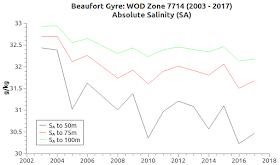 |
| Fig. 1 Beaufort Gyre in safe rotation |
The graphic at Fig. 1 shows the safe counter-clockwise rotation of the Beaufort Gyre.
It also shows a general description of three general concept layers in the gyre.
The graphs (Fig. 2a - Fig. 6b) show the Conservative Temperature (CT) and Absolute Salinity (SA) at various depths over the years.
The Woods Hole Oceanographic Institute (WHOI) has been studying the phenomenon since 2003 (Beaufort Gyre Exploration Project), and providing data for us to use at no cost as I have explained (Mysterious Zones of The Arctic, 2).
 |
| Fig. 2a CT 50m - 100m |
 |
| Fig. 2b SA 50m - 100m |
"When this ocean current spins clockwise [as it is now], it traps Arctic ice and freshwater melt. When it spins the other way [as in Fig. 1], it ejects that ice and freshwater out past Greenland into the North Atlantic, making weather in Northern Europe cooler. It is a natural phenomenon, but something has gone awry with the way it operates, as its periodic reversal is way overdue."(Public Radio International (PRI), emphasis added). The general process of the gyre over time has been to change rotation periodically.
 |
| Fig. 3a CT 125m - 300m |
 |
| Fig. 3b SA 125m - 300m |
 |
| Fig. 4a CT 400m - 800m |
 |
| Fig. 4b SA 400m - 800m |
In terms of time the change in rotation is overdue, but in terms of what will happen if it does change after being hung up so long is more clear.
It is likely to be bad for fishing in the North Atlantic because it is expected to cause a cooling of temperatures in some parts of Europe.
The study being done by the WHOI is spot on.
And as I have written in this series in earlier posts, their sharing of very good data is laudable.
 |
| Fig. 5a CT 900m - 1300m |
 |
| Fig. 5b SA 900m - 1300m |
 |
| Fig. 6a CT 1400m - 1750m |
 |
| Fig. 6b SA 1400m - 1750m |
"Today, the Beaufort Gyre holds as much freshwater as all of the Great Lakes combined, and its continuing clockwise swirl is preventing this enormous volume of ice and cold, fresh water from flushing into the North Atlantic Ocean. But, scientists say, the gyre will inevitably weaken and reverse direction, and when it does it could expel a massive amount of icy fresh water into the North Atlantic. Polar oceanographer Andrey Proshutinsky of the Woods Hole Oceanographic Institution has labeled this anticipated surge of water a “ticking climate bomb,” noting that even a partial flush of that growing reservoir — a mere 5 percent — could temporarily cool the climate of Iceland and northern Europe and have a major impact on commercial fisheries in the North Atlantic"(Yale Environment 360, emphasis added). The mystery of the clockwise rotation hang-up continues.
That said, the content of the gyre at this time is not so mysterious, thanks to WHOI monitoring.
The paired graphs (Fig. 2a - Fig. 6b) of CT and SA at various depths generally indicates that the shallower depths contain cooler, fresher water, i.e., cooler temperatures (CT) and lower salinities (SA).
The mid-range depths have warmer water temperatures (CT) and increasing amounts of salinity (SA).
The deepest waters generally have cooler water, but more salinity.
We will keep an eye on this mysterious WOD Zone 7714 to find out what else, besides the cooling effect the expected reversal will have on Europe.
But we also need to watch the additional effect the flushing of the colder water will have on the already warming Arctic itself.
I need to close now and get to work on the new, enormous database I downloaded from the WOD (Databases Galore - 22).
Stay tuned.
The previous post in this series is here.





